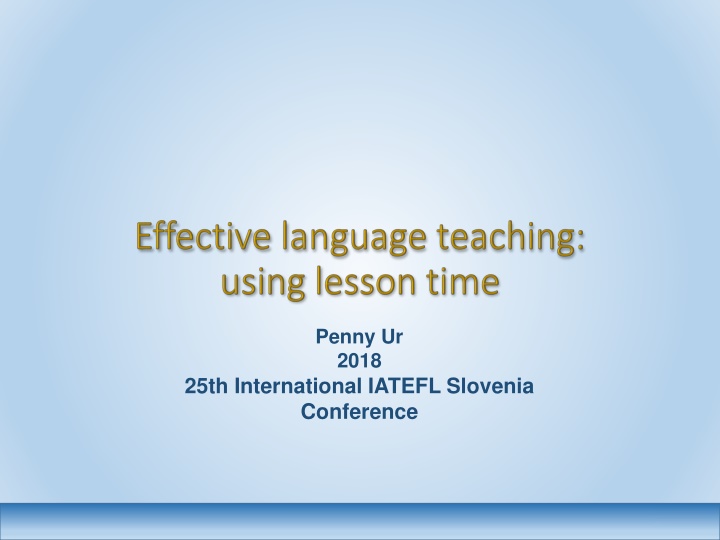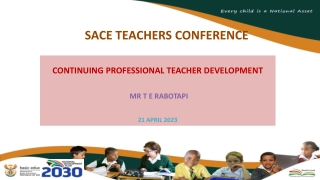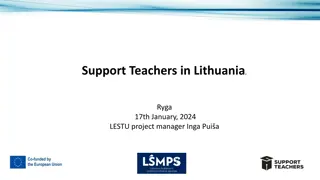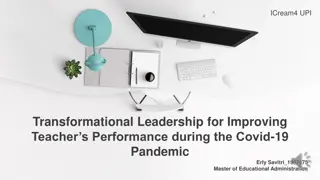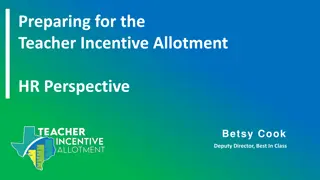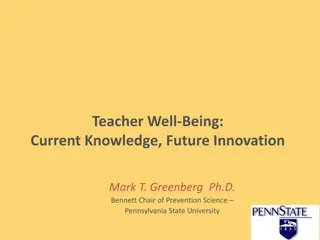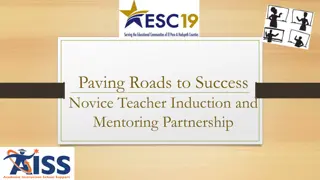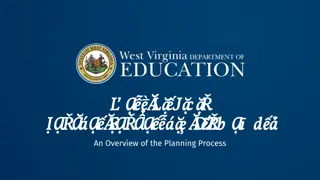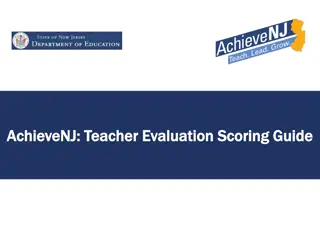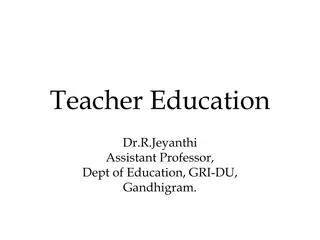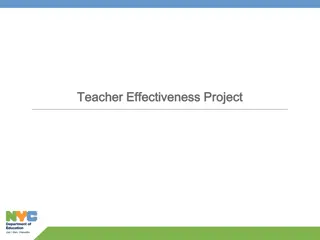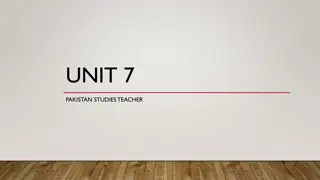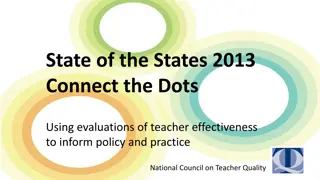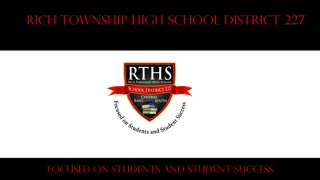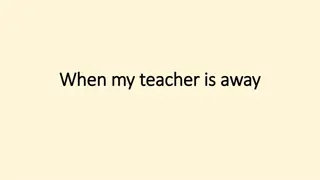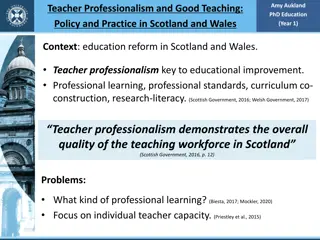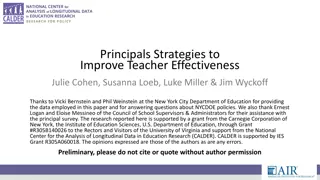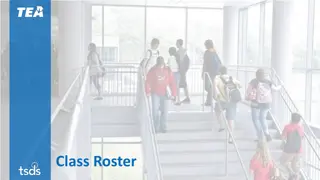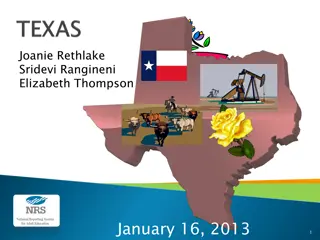Characteristics of an Effective Teacher: Key Criteria
Defining traits of effective teachers and the importance of each, key aspects like student motivation, classroom climate, task-based lessons, student engagement, learning outcomes, lesson organization, and teacher-student rapport are considered. The end goal of effective teaching, whether means-oriented or end-oriented, is achieving successful learning outcomes through various teaching strategies.
Download Presentation

Please find below an Image/Link to download the presentation.
The content on the website is provided AS IS for your information and personal use only. It may not be sold, licensed, or shared on other websites without obtaining consent from the author.If you encounter any issues during the download, it is possible that the publisher has removed the file from their server.
You are allowed to download the files provided on this website for personal or commercial use, subject to the condition that they are used lawfully. All files are the property of their respective owners.
The content on the website is provided AS IS for your information and personal use only. It may not be sold, licensed, or shared on other websites without obtaining consent from the author.
E N D
Presentation Transcript
Penny Ur 2018 25th International IATEFL Slovenia Conference
The following seven statements describe possible defining characteristics of an effective teacher. How important is each? Which would in your opinion be the most important, or key criterion for effective teaching? 2
1.Students are clearly motivated to come to his/her classes. 2.He/She creates a supportive classroom climate. 3.His/Her lessons are based on communicative task-based work. 4.His/Her students are constantly activated in class. 5.His/Her students learn English well. 6.His/Her lessons are orderly; students are consistently on-task. 7.He/She loves his/her students. 3
Task Achievement look for find listen hear look see study learn Ryle (1949/1984) 4
I learned French when I was in Paris. I studied French when I was at school. 5
Task Achievement look for find listen hear look see study learn teach teach 6
He taught me history for years, but I never learnt anything She taught me to swim. They teach for a living. My goal is to teach my students English. 7
Teaching can be seen as a) means-oriented (task, process, facilitation of learning, creating conditions for learning), or as b) end-oriented (achievement, product, leading to learning). Effective teaching is that which achieves the end. The means should be evaluated chiefly on the basis of how well they contribute to this end 8
1.Students are clearly motivated to come to his/her classes. 2.He/She creates a supportive classroom climate. 3.His/Her lessons are based on communicative task-based work. 4.His/Her students are constantly activated in class. 5.His/Her students learn English well. 6.His/Her lessons are orderly; students are consistently on-task. 7.He/She loves his/her students. 9
1.Students are clearly motivated to come to his/her classes. 2.He/She creates a supportive classroom climate. 3.His/Her lessons are based on communicative task-based work. 4.His/Her students are constantly activated in class. 5.His/Her students learn English well. 6.His/Her lessons are orderly; students are consistently on-task. 7.He/She loves his/her students. 10
Doesnt help very much: too many different components and models But it seems clear that the choice of methodology is not a crucial factor. (Clarke et al., 1996) 11
The more effective the teaching, the more real learning will take place in any given unit of time. Research on academic learning time (ALT) Berliner, 1990; Gettinger & Walter, 2015 12
time in school time in lesson teaching time time on task learning time 13
1. Profitless busy work 2. Wrong choice of language 3. Inappropriate interaction pattern 14
Tasks that involve a lot of (sometimes interesting / absorbing) activity that does not contribute much to learning: Time spent puzzling out; searching; organizing group work; formatting/designing. 16
I Y H S H O N Y T F P M D M J 1 picture 2 computer 3 dog 4 clothes 5 house 6 sun 7 moon 8 bag 9 bottle 10 foot 11 tree 12 flower 13 cup 14 key 15 cat 16 present (n) 17 eyes 18 ball 19 telephone 20 fish D X Z O C R C E E R T R E X E R V U F O F L T E K M U F F Y E S R I M E Z S I L K N G J U E Y E S P I E N Z B I I K N A F V W H U N U S C X W C W B D K G O D T O O F U A L J O Y G H N L W E O L E B B Q V G H V E V F X R M L U G F D G N R E E A R X U T A C W P F W U R N I E M R T S B T M Q H Z G F Y E N Y O C I A I H I L S M E Z B P B K I N G Y X A K F L G H A V A T P U C S T P E F F R W Q Q L M D M F Q W Z V U M B Y
1 picture 2 computer 3 dog 4 clothes 5 house 6 sun 7 moon 8 bag 9 bottle 10 foot 11 tree 12 flower 13 cup 14 key 15 cat 16 present (n) 17 eyes 18 ball 19 telephone 20 fish T C U P H E K P E N 0 L F L 0 W E R A T P O O C U F Y E S E I T O A S I T S T Y C H T T E S O E R E T E L E P H O N E S U S C O M P U T E R R U H B O T T L E F E N A D O G B A L L C A T I N O B O D Y
bicycle because people independent embarrassed friend encourage privilege building enough
Students are given a minute or two to look at the words. The words are deleted / hidden, they try to remember as many as they can. They then join with classmates, try see how many they can remember together. The teacher reveals the words again. The activity activates the students for a high proportion of the time actively engaging with the target material. 20
Express approval Explain the meaning of a new word Explain a tricky grammar point Give instructions 22
Probably English: a good opportunity to teach and use phrases such as: very good nice well done excellent I like it that s great amazing brilliant good for you 23
Very often L1. Pictures and mime may be ambiguous. English explanations / synonyms are less precise may not be understood take more time 24
Probably L1 The language that describes the grammar is often more difficult than the usage itself. The students mother tongue is faster: leaves more time for engaging with English use of the grammar feature itself. 25
For advanced classes: in English. For beginner / intermediate: Simple, standard instructions: in English. Complex instructions for group / individual work, or homework in L1. 26
1. Teacher talk 2. Teacher elicits from single individual learner (closed- ended) 3. Teacher elicits from full class (closed-ended choral) 4. Teacher elicits from multiple individual learners (open-ended) 5. Individual learner elicits from teacher 6. Full-class discussion 7. Collaboration 8. Individual work 9. Group/pair work 10. Self-access 28
Objective Interaction pattern Get learners to understand a point of grammar Get learners to produce instances of a grammatical structure (practice) Get learners to talk Improve learners writing skills through short writing assignments Improve learners reading fluency 29
Objective Interaction pattern Elicitation (teacher individual) Teacher explanation (teacher talk) Get learners to understand a point of grammar Get learners to produce instances of a grammatical structure (practice) Get learners to talk Improve learners writing skills through short writing assignments Improve learners reading fluency 30
Objective Interaction pattern Elicitation (teacher individual) Teacher explanation (teacher talk) Get learners to understand a point of grammar Get learners to produce instances of a grammatical structure (practice) Elicitation from single learners (closed-ended) Elicitation from multiple learners (open-ended) Get learners to talk Improve learners writing skills through short writing assignments Improve learners reading fluency 31
Objective Interaction pattern Elicitation (teacher individual) Teacher explanation (teacher talk) Get learners to understand a point of grammar Get learners to produce instances of a grammatical structure (practice) Elicitation from single learners (closed-ended) Elicitation from multiple learners (open-ended) Full-class discussion Group-pair work Get learners to talk Improve learners writing skills through short writing assignments Improve learners reading fluency 32
Objective Interaction pattern Elicitation (teacher individual) Teacher explanation (teacher talk) Get learners to understand a point of grammar Get learners to produce instances of a grammatical structure (practice) Elicitation from single learners (closed-ended) Elicitation from multiple learners (open-ended) Full-class discussion Group-pair work Collaboration Individual work Get learners to talk Improve learners writing skills through short writing assignments Improve learners reading fluency 33
Objective Interaction pattern Elicitation (teacher individual) Teacher explanation (teacher talk) Get learners to understand a point of grammar Get learners to produce instances of a grammatical structure (practice) Elicitation from single learners (closed-ended) Elicitation from multiple learners (open-ended) Full-class discussion Group-pair work Collaboration Individual work Get learners to talk Improve learners writing skills through short writing assignments Get individual learners to read aloud round the class (closed-ended) Teacher reads aloud, learners follow (teacher talk) Individual / self access (silent reading) Improve learners reading fluency 34
Usually: the teacher explains: likely to be quicker, clearer, more accurate. Sometimes, if the students are able to explain: elicit. 35
Usually: open-ended cues These elicit more responses, which are more varied and interesting for the class, and provide more practice. 36
Mainly individual. Writing is essentially an individual activity. Pair work: for planning, editing. 37
Mainly individual silent reading At earlier stages, reading along with the teacher can be very helpful. NOT (usually) reading aloud round the class. 38
1. Effective teaching is first and foremost that which brings about effective learning. 2. Effective teaching is primarily a function of appropriate use of time in lessons for learning. 40
1. How might the age / level / character of the class affect our priorities? 2. Is effective learning of English in a lesson always our main objective? 3. Are there situations where short-term ineffective lessons may lead to long-term benefits? 4. Are there situations where time-wasting activities are actually a good idea? 41
There may be various considerations in making decisions as to what to include in a lesson, but the most important ( default ) principle should be: What will bring about the most effective learning on the part of my students in the lesson-time at my disposal? 42
Berliner, D. C. . (1990). What's all the fuss about instructional time?. In Ben-Peretz, M., & Bromme, R. (Eds.), The nature of time in schools: theoretical concepts, practitioner perceptions (pp.3-35). New York: Teacher's College Press. Clarke, M. A., Davis, A., Rhodes, L. K., & Baker, E.. (1996). Creating coherence: High achieving classrooms for minority students. Denver, Colorado: University of Colorado at Denver. Gettinger, M., & Walter, M. J. (2012). Classroom strategies to enhance academic engaged time. In Handbook of research on student engagement (pp. 653-673). Springer, Boston, MA. Ryle, G. 1984. The Concept of Mind. Chicago: University Of Chicago Press. 43
Happy: Smiley%2520Face_kleiner Happy = vesel / vesela
